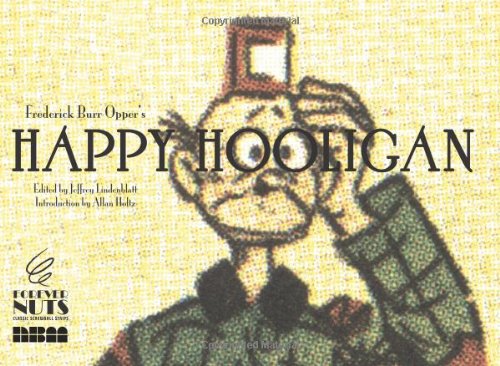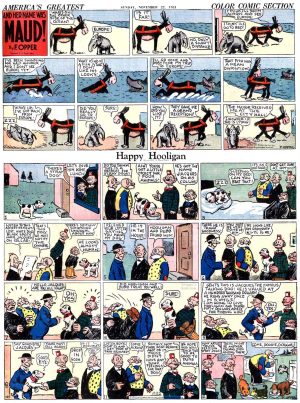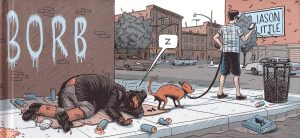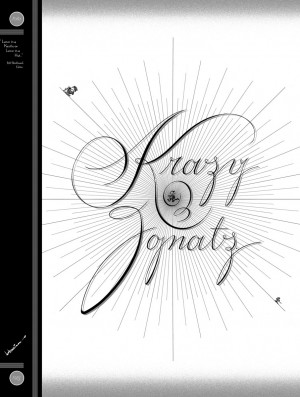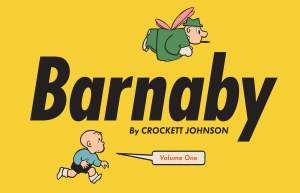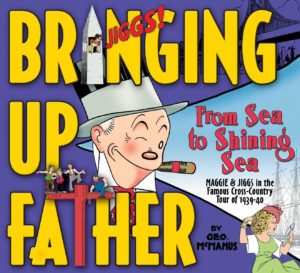Review by Win Wiacek
Frederick Burr Opper was one of the first true giants of comic strips: a hugely imaginative, highly skilled and immensely well-regarded illustrator and political cartoonist who moved into the burgeoning field of newspaper cartooning just as the medium was being born. His pictorial creations and even more so, his dialogue have enriched western culture and the English language.
Starting on the New York Journal’s Sunday supplement, he devised a wealth of different features beginning with Happy Hooligan which debuted on 11th March 1900. Many cartoon strippers of the fledgling art form were given great leeway to experiment with a variety of ideas in those early days, so although not a regular feature at the start, before too long it became simply too popular to miss. Opper settled into a stable tenure that lasted until 1932 when the artist’s failing eyesight led to his retirement, and he passed away at the end of August 1937.
Happy Hooligan is an affable, well-meaning but painfully bumbling tramp who wears an old tin-can for a hat. Always ready and eager to assist and wishing nobody ill, this gentle vagrant is constantly made the inadvertent tool and plaything of far more fortunate folk who should know better, or cops a little too fond of the truncheon and nightstick, and generally a harsh, unforgiving cosmos of ill-fortune.
It’s a strip brimming with invention, pathos, social commentary, delightful wordplay and broad, reckless slapstick. More than one source cites Happy as having a profound influence on Charlie Chaplin’s Little Tramp in both content and tone.
This classy hardback presents a selection of strips in the varying forms of colour (two, three and full colour depending presumably on the budget of the local papers these rare survivors were culled from). The tome is compiled and edited by Jeffrey Lindenblatt with a fascinating introduction and biography from Allan Holtz who, with collector Cole Johnson, provided the majority of the strips included here.
These range from June 8th 1902 to September 7th 1913 and although by no means complete or comprehensive they afford a tantalizing glimpse at this iconic, influential and groundbreaking feature. Many reprints come from the highly productive and hilarious “Grand Tour” years of 1904 and 1905. This follows the sedentary sad-sack across the sea to England and then on to the unsuspecting continents of Europe and Africa before returning to America in 1906.
With brothers Montmorency and Gloomy Gus, plus a burgeoning family of nephews and hangers-on, this too-slim tome ends with some of the optimistic poltroon’s foredoomed attempts to woo Suzanne, the patient and amazingly egalitarian daughter of the Duke of Cabaret. These hysterical, rowdy escapades are often exacerbated by occasional visits from the ultra-polite Alphonse and Gaston, Opper’s legendary French gentlemen of extreme etiquette elitism.
Crossovers were not Opper’s only innovation. Happy Hooligan is considered as the first American strip to depend on word balloons rather than supplemental text, and the humble, heartwarming hobo was also the first strip character to jump to cinema in six movie shorts from 1900-1902. He was also probably the first mass-market merchandising comics star.
Sadly, Opper and his creations become less well-known with each passing year, but the quality of the work can never fail to amuse and inspire. Hopefully one day soon superb graphic appetisers such as this will lead to further, more comprehensive collections, and as this book also contains a healthy selection of Opper’s other works, perhaps we can also look forward to compendia of his other seminal sketches and comedy classics.
